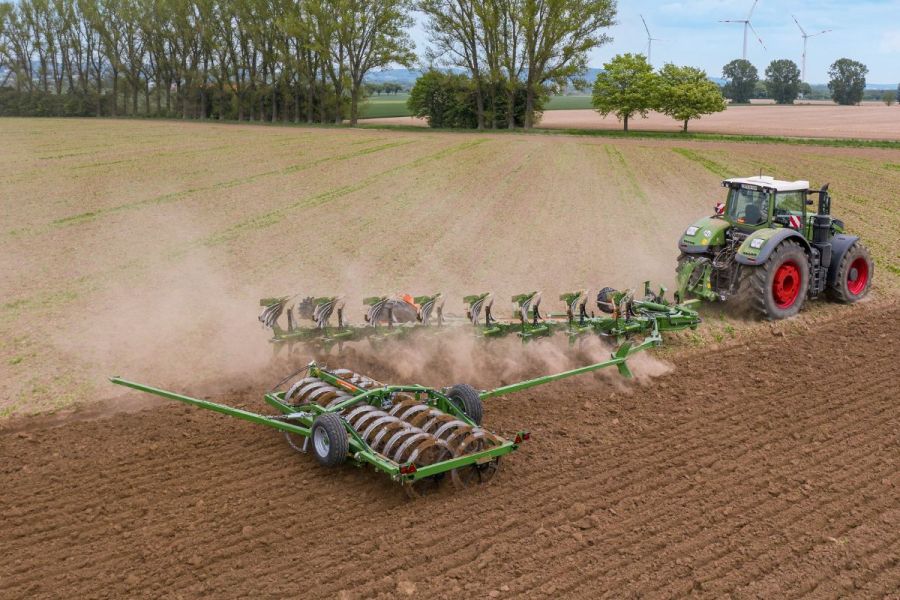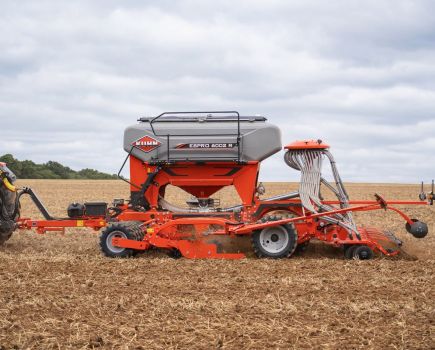As harvest approaches, CPM takes a look at some new and some familiar machines that will soon go to work after the combine, from balers to tillage equipment.
By Melanie Jenkins
Groundwork preparations are often the set up at the start of the season, meaning getting the desired seedbed is of vital importance, and requires the right machine for the job at hand, be it a cultivator or a plough. Here’s a look at some of the latest launches and farm staples from manufacturers.
Amazone
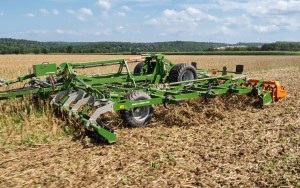
Amazone’s Cobra was launched to meet the demands of the growing market for machines that work the top 5cm to help chit stubbles behind the combine.
A new addition to Amazone’s stable is the KE 6002 2-400 Rotamix rotary harrow. Released at the end of last year, the latest version of the KE 02 Rotamix range comes as a 6m variant for use with tractors up to 400hp.
The machine has been designed with high work rates in mind, with a quick folding 3m transport width, but be aware that it’s been designed for solo use and therefore can’t be coupled with a seed rail, advises the firm’s Simon Brown.
Amazone’s Quick+Safe system provides the 29cm tines with an integrated stone release and the tines can be easily exchanged without the need for tools The trailing tines are designed to produce a good crumb structure, including on heavier soils. This means the Rotamix should be well suited for seedbed preparation, particularly behind a plough.
According to Simon, the heart of the new rotary harrow range is the DirectDrive gearbox – mounted on both side wings – via which the higher power flow is transmitted directly to the spur gears of the tine carriers. On the new model, there’s no power redirection to ensure a low-wearing power transmission. The short coupling ensures that the leverage effect on the tractor is reduced, and therefore it should have a lesser lifting power requirement than with some other rotary harrows. The rotary harrow can be used with a PTO speed of 1000rpm, and exchange gear sets enable the tine carrier speed to be adapted to the different soil conditions.
To achieve precise and consistent working depth settings, the machine can be precisely adjusted mechanically via a series of holes with an eccentric pin which has been designed to be easily altered by the operator.
The height of the levelling board is guided by the roller and deflects upwards due to integrated overload protection. And the levelling board has been shortened by 10cm for improved soil passage and for better levelling of the soil.
And a number of roller types with varying diameters are available for targeted reconsolidation. The tooth packer roller provides full area crumbling and reconsolidation, while the wedge ring roller – for light to medium soils – reconsolidates in strips and comes with optional Matrix profile for better drive in lighter soils. And lastly, the trapezium roller also allows for strip reconsolidation.
Earlier in 2022, Amazone introduced its Cobra shallow tine cultivator, available in working widths of 6m and 7m. “It meets the demands of the growing market for machines that work the top 5cm and chits stubbles behind the combine,” says Simon. “The Cobra provides farmers with a different type of machine compared with those that have been previously available.”
The Cobra utilises the standard semi-trailed TX frame format of swivel drawbar and braked, central running gear for perfect weight distribution, tight headland turns and safe, comfortable, high-speed travel on the road, says Simon.
The machine has six rows of tines, spaced at 13.3cm, with a tip-to-tip clearance of 80cm and a frame height of 60cm, meaning it should be capable of handling copious amounts of crop residues at high forward speeds without blockages, he explains.
“For use in cover crops, the leading knife roller bruises the foliage speeding up the breakdown of the organic matter and presenting the longer stalks in the ideal orientation to be handled by the ECO leaf spring tines.”
These tines can be equipped with a choice of narrow points or duck foot shares depending on the task in hand; when using the duck foot option, the tines have an overlap of nearly 9cm. Maximum working depth is 13cm and the Cobra can be specified with any one of nine rear rollers or the double harrow.
Grange
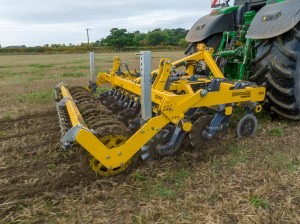
Grange’s Strip-Till Preparator has been designed with input from farmers looking for the ideal tool to help establish their maize, sugar beet or brassica crops.
Grange Machinery has added a new product line this year, aimed at helping farmers reap the benefits of strip-till cultivations.
Designed with input from farmers looking for the ideal tool to help establish their maize, sugar beet or brassica crops, the Strip-Till Preparator has been developed over several seasons and is now available in 3m, 4m and 6m working widths; and requires a minimum of 210hp.
“We designed and built three prototype machines which had various changes and additions to the frame and the general layout in the row to achieve a truly effective and versatile implement,” explains the firm’s Rhun Jones. “It’s essential to get the design of this type of machine exactly right to make the perfect strip to allow targeted planting and application of fertiliser, making the best use of costly inputs, preserving moisture and improving soil quality.”
Three independent rows of cultivation discs can be hydraulically adjusted while working in harmony with a low disturbance tine and point, a feature which should allow the Preparator to create an ideally cultivated row that is ready for planting.
A zonal Guttler prism roller ring performs the final part of the cultivation pass to break down any clods that have flowed through the system as well as consolidating the row in readiness for a planter.
Another feature if the Preparator offers is the option of applying either granular or liquid fertiliser behind the loosening tine.
Leg spacings can be set at different row centres to suit a range of sowing systems and crops. Hydraulic front cutting discs are fitted for trash management and to provide minimal disturbance. The Strip-Till Preparator is now in full production and can be seen working this season.
Horsch
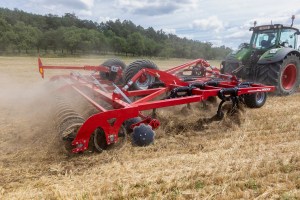
The Fortis 6 and 7 AS, have 6m and 7m working widths, respectively, and can operate with a working depth between 40cm and 30cm – aimed at deep loosening and primary tillage.
The Fortis AS is a new cultivator from Horsch that has been developed to work with tractors powered up to 600hp, as well as providing more flexibility in working depth and adjustment options.
The Fortis 6 and 7 AS, have 6m and 7m working widths, respectively, and can operate with a working depth between 40cm and 30cm – aimed at deep loosening and primary tillage. Depending on the conditions, the operator can decide to manoeuvre on the packer or on the chassis, and the changeover is carried out simply by means of a three-way valve.
The design of the packer focuses on flexibility with the options to select the type of packer and whether it’s connected rigidly to the frame or pretensioned hydraulically. In the pretensioned option, the weight of the front packer roller can be transferred to the rear roller preventing sinking on light soils.
To ensure a consistent levelling quality in this wide working range, the fourth bar was placed further backwards so there’s always enough loose earth in front of the levelling discs to achieve the desired result. The 27cm tine spacing on the four-bar design is suitable for shallow tillage and an all-over cutting in all conditions, but also meets the requirements for a lower horsepower tractor performing deep primary tillage.
The option of single or double front support wheel is intended to offer precise soil adaption, ranging from a simple depth control to supporting the machine in case of high working depths. The depth adjustment can either be carried out by the clip system or fully hydraulically from the cab. The Fortis is equipped with an integrated traction reinforcement system which transfers up to 1.2t to the rear axle of the tractor to help prevent slippage.
Lemken
The new Karat 10 three-beam cultivator from Lemken is available as both a mounted and semi-mounted machine and comes in working widths of 3m and 7m. Tines are arranged symmetrically around the tensile axis for a low draught and to avoid side draft, which is important when using the cultivator with track guidance systems.
The wing shares, aimed at shallow cultivation, have been widened, and alternatively, narrow shares can be used for deep cultivation. DeltaCut shares can be used for ultra-shallow cultivation, and the standard quick-change system allows them to reach working depths of up to 30cm.
Centrally adjustable levelling tines are designed for an even finish and specially shaped levelling discs, which are for heavy soils, are optionally available. Also newly available are boundary discs and tines that can be folded up mechanically or hydraulically.
The cultivator can be equipped optionally with a hydraulically adjustable leading disc section. This ensures that large volumes of organic matter can be incorporated into the soil. The discs, which are individually suspended on leaf springs, chop organic matter and break up coarse soil clumps so that the machine can mix soil intensively and work without clogging.
A traction booster and the ContourTrack system, which ensures an even working depth in hilly terrain, are available for the semi-mounted models.
HE-VA
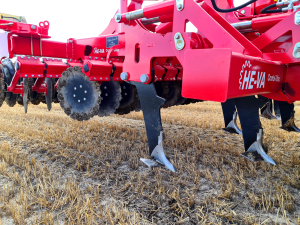
The ‘Stealth’ variant of this He-Va Combi-Disc combination cultivator is now available in working widths of 2.45m and 5.25m in both mounted and trailed formats.
This year’s Cereals Event was the launch pad for the new version of the three-in-one cultivator, the He-Va Combi-Disc from Opico. The ‘Stealth’ variant of this combination cultivator is now available in working widths of 2.45m and 5.25m in both mounted and trailed formats. It has ultra-low disturbance legs and a choice of different points, depending on the level of sub-surface action required.
Two leading rows of soil loosening legs are followed by two rows of serrated Sabre discs to provide a surface chopping and mixing effect. This is all followed up with a V-profile roller to create a corrugated, weather-proof finish.
In normal circumstances the tines, discs and press are used in partnership to turn previously uncultivated ground into a seedbed in one pass. But when conditions require it, the discs can be lifted completely out of work, enabling the unit to be used as a straightforward subsoil loosener/pan-buster or as a straightforward shallow disc cultivator.
“With the increased focus on regenerative practices, we’re seeing a desire for cultivation kit that can reduce soil disturbance but still deal with compacted layers in the soil profile to ensure decent drainage and rooting to maximise crop potential,” explains Opico’s territory manager and product specialist for HE-VA, Glenn Bootman. “With this new leg option, the basic principle is medium-depth, low disturbance soil loosening combined with shallow surface cultivation.”
The 15mm wide Stealth leg allows deep soil loosening while minimising surface disturbance and preventing mixing of the soil profile. The narrower legs are made from ultra-strong Hardox steel and can be interchanged with standard 25mm wide subsoiler legs as necessary. The Stealth standard 12cm low disturbance point has a shallower wing angle and shorter nose, designed to open up the soil to create drainage fissuring without mixing the whole soil profile.
Väderstad
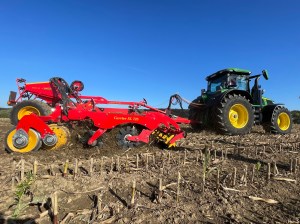
Väderstad’s latest disc cultivator comes in the form of the Carrier XL 725 – a 7.25m machine that bridged a gap in the existing models.
Last year saw Väderstad introduce a number of upgrades and additions to its range of cultivation equipment, including the CrossCutter Disc Aggressive, with sharpened TrueCut cut outs that provide higher penetrative capabilities in challenging field conditions.
The firm’s latest disc cultivator came in the form of its Carrier XL 725 – a 7.25m machine that bridged a gap in the existing models, which range from 4.25m to 12.25m. The machine is available with 51cm TrueCut discs, CrossCutter Disc or the new CrossCutter Disc Aggressive.
On the compact disc cultivator front, Väderstad’s Carrier XT is based on the former Carrier X and is available in a mounted, mounted galvanised and in a trailed version, and has working widths of 4.25m, 5.25m and 6.25m. The main feature of the machine is its hydraulically rotating disc angles.
Moving into the foldable cultivators, the Cultus HD 425 and 525 are available in working widths of 4.25m or 5.25m and can work to depths of 30cm and is equipped with three tine axles, resulting in a tine spacing of 27cm.
The heart of the machine is made up of the new heavy-duty tines which have a release force of up to 680kg, allowing the machine to work in a full range of conditions.
This article was taken from the latest issue of CPM. Read the article in full here.
For more articles like this, subscribe here.
Sign up for Crop Production Magazine’s FREE e-newsletter here.

